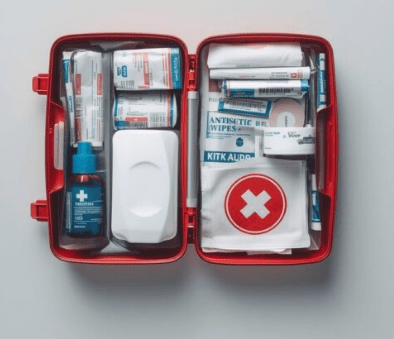Home Safety Matters More Than Ever
Home safety has always been important, but in 2025 it’s taken on new urgency. With technology changing, weather patterns becoming more unpredictable, and households filled with a mix of older adults, children, and smart devices, the risks are more diverse than they’ve ever been. Preventable accidents like fires, carbon monoxide poisoning, and falls remain leading causes of injury at home, and preparedness is the best defense.
This guide breaks down the essentials of home safety in 2025—from fire extinguishers and carbon monoxide detectors to fall prevention, safe appliance use, and weather readiness. Whether you live in a small apartment or a large home, these safety basics can help you reduce risks, protect your family, and create peace of mind.
Fire Safety: The Foundation of Home Protection
Fire is one of the most destructive hazards a household can face, and most fires start small—often in the kitchen. Quick response makes all the difference, which is why fire preparedness is step one in any safety checklist.
Two Fire Extinguishers Are Non-Negotiable
Every home should have at least two fire extinguishers in 2025:
- Kitchen Fire Extinguisher – Cooking remains the number one cause of home fires. A small grease flare-up can quickly spread to cabinets or countertops. Keep a multi-purpose (Class A, B, C) extinguisher within easy reach of your kitchen but away from the stove itself.
- Garage or Storage Area Extinguisher – Garages and storage rooms often contain flammable items—gasoline, paint, propane tanks, or cleaning chemicals. Having a second extinguisher here ensures you can respond to a fire quickly without running back inside.
Check your extinguishers annually, make sure pressure gauges are in the green zone, and replace them if expired. In an emergency, remember the acronym PASS: Pull, Aim, Squeeze, Sweep.
Smoke and Carbon Monoxide Detectors: Silent Life-Savers
Fire kills by smoke inhalation long before flames spread, and carbon monoxide (CO)—a colorless, odorless gas—is often called the “silent killer.”
Best Practices for Detectors in 2025
- Install a smoke detector on every floor, inside each bedroom, and outside sleeping areas.
- Place at least one carbon monoxide detector near bedrooms and another near appliances that burn fuel (gas stoves, water heaters, or fireplaces).
- Choose smart detectors where possible. Many models now send alerts directly to your phone, ensuring you’re warned even when away from home.
- Test detectors monthly and replace batteries at least once a year (or choose 10-year sealed models for less maintenance).
These devices are inexpensive but among the most important home safety tools available.
Preventing Falls: A Growing Home Safety Concern Especially in Aging Households
Falls are one of the leading causes of home injuries, especially as populations age. In 2025, more seniors are aging in place, making fall prevention a priority.
The Importance of a Sturdy Step Stool
Reaching high shelves or cabinets is a common scenario where people get hurt. Using chairs, unstable ladders, or makeshift climbing solutions dramatically increases fall risk. A sturdy, non-slip step stool with a handle is one of the simplest and smartest safety upgrades for any household.
Other Fall-Prevention Tips
- Keep floors clear of clutter and cords.
- Install grab bars in bathrooms, especially near showers, tubs, and toilets.
- Add non-slip mats in kitchens and bathrooms.
- Ensure proper lighting, especially on stairways and entryways. Motion-sensor lights are great for nighttime safety.
These steps don’t just protect older adults—everyone benefits from a fall-safe home.
Gas and Propane Appliance Safety
Many homes still rely on natural gas or propane for cooking, heating, or hot water. While these fuels are efficient, they also carry risks if not properly monitored.
Safety Steps for Gas and Propane Users
- Install a gas leak detector in areas where appliances are located. Smart sensors now alert you via phone if dangerous leaks occur.
- Ensure proper ventilation around stoves, water heaters, and furnaces. Poor ventilation increases carbon monoxide buildup.
- Have appliances inspected annually by licensed professionals. Small leaks or loose fittings can lead to dangerous situations.
- Know where your shutoff valve is. In the event of a strong smell of gas (often like rotten eggs), leave immediately and call your utility company.
Monitoring devices are better and more affordable in 2025, so there’s little excuse not to install them.
Weather Preparedness: Stay Ahead of Storms
Extreme weather is becoming more common. Tornadoes, hurricanes, floods, and severe thunderstorms are happening in areas previously less affected. Being weather-ready is no longer optional.
Must-Have for Home Safety: A NOAA Weather Radio
A battery-powered or hand-crank NOAA weather radio provides real-time alerts directly from the National Weather Service. These alerts can warn you of:
- Severe thunderstorms
- Tornadoes
- Flash flooding
- High wind events
Cell networks can go down during storms, but NOAA radios remain reliable. Look for models with SAME (Specific Area Message Encoding) so you only receive alerts relevant to your county.
Consider a Home Weather Station
For those living in especially vulnerable areas, investing in a home weather station in 2025 is an invaluable need for home safety. These stations monitor local temperature, wind speed, humidity, and rainfall. Some even integrate with smart home systems, alerting you instantly if dangerous conditions develop.
First Aid Preparedness
A comprehensive first aid kit is another must-have in every household. Accidents happen, and being able to respond quickly can make a huge difference.

Essentials for 2025 Kits
- Adhesive bandages of various sizes
- Antiseptic wipes and ointments
- Elastic bandages for sprains
- Digital thermometer
- Tweezers and scissors
- Disposable gloves
- Pain relievers (acetaminophen, ibuprofen)
- Emergency contact list and medical info
Store kits in an easily accessible spot and check them annually to replace expired items.
Cyber-Safety and Security: A Modern Addition to Home Safety in 2025
Home safety isn’t just about physical risks anymore. With smart locks, cameras, and Wi-Fi-enabled appliances, digital threats are part of the equation.
Digital Safety Measures
- Use strong, unique passwords for all smart home devices.
- Set up two-factor authentication where possible on often used websites and especially those sites that involve finance and work.
- Consider Using a quality VPN on all computers and devices – even your phone.
- Keep software and firmware updated to patch critical vulnerabilities.
- Secure your Wi-Fi network with at least WPA3 encryption.
Protecting your home’s digital infrastructure is now as important as locking the front door.
Power Outage Preparedness for Home Safety
Another critical area of home safety is being prepared for power loss. Outages can disrupt heating, cooling, and communications.
Recommendations
- Backup power solutions: Consider a portable generator or whole-house backup system. If using gas-powered generators, keep them outside and away from windows to prevent CO poisoning.
- Flashlights and lanterns: Stock multiple reliable LED flashlights with extra batteries. Always avoid candles, which increase fire risk.
- Backup charging banks for phones and small electronics.
Bringing It All Together
Home safety in 2025 is a mix of timeless basics and modern upgrades. From fire extinguishers and smoke detectors to weather radios and cyber protection, every step adds layers of protection for you and your loved ones.
Quick Home Safety Checklist
- Two fire extinguishers (kitchen + garage/storage)
- Smoke and carbon monoxide detectors on every level
- Sturdy step stool and fall-prevention measures
- Gas and propane monitoring devices
- NOAA weather radio (plus optional home weather station)
- Well-stocked first aid kit
- Cyber-safety practices for smart devices
- Backup power solutions and flashlights
A safer home isn’t built overnight, but taking consistent steps ensures your family is protected against the most common—and most dangerous—household hazards.
Final Thoughts
Your home is your safe sanctuary. In 2025, safeguarding it requires both awareness of traditional risks and readiness for new ones. By focusing on fire protection, fall prevention, safe fuel use, weather alerts, modern safety upgrades, and cyber secutiry, you can dramatically reduce your household’s vulnerability.
Think of home safety as an ongoing investment—one that pays off in security, peace of mind, and the well-being of everyone who walks through your door.
Work Safety is Important too. Check out this article about Preventing Sips and Falls in the workplace.















